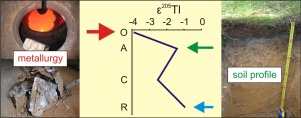当前位置:
X-MOL 学术
›
J. Hazard. Mater.
›
论文详情
Our official English website, www.x-mol.net, welcomes your
feedback! (Note: you will need to create a separate account there.)
Thallium isotopes in metallurgical wastes/contaminated soils: A novel tool to trace metal source and behavior
Journal of Hazardous Materials ( IF 12.2 ) Pub Date : 2017-09-12 , DOI: 10.1016/j.jhazmat.2017.09.020 Aleš Vaněk , Zuzana Grösslová , Martin Mihaljevič , Vojtěch Ettler , Jakub Trubač , Vladislav Chrastný , Vít Penížek , Leslaw Teper , Jerzy Cabala , Andreas Voegelin , Tereza Zádorová , Vendula Oborná , Ondřej Drábek , Ondřej Holubík , Jakub Houška , Lenka Pavlů , Christopher Ash
Journal of Hazardous Materials ( IF 12.2 ) Pub Date : 2017-09-12 , DOI: 10.1016/j.jhazmat.2017.09.020 Aleš Vaněk , Zuzana Grösslová , Martin Mihaljevič , Vojtěch Ettler , Jakub Trubač , Vladislav Chrastný , Vít Penížek , Leslaw Teper , Jerzy Cabala , Andreas Voegelin , Tereza Zádorová , Vendula Oborná , Ondřej Drábek , Ondřej Holubík , Jakub Houška , Lenka Pavlů , Christopher Ash

|
Thallium (Tl) concentration and isotope data have been recorded for contaminated soils and a set of industrial wastes that were produced within different stages of Zn ore mining and metallurgical processing of Zn-rich materials. Despite large differences in Tl levels of the waste materials (1–500 mg kg−1), generally small changes in ε205Tl values have been observed. However, isotopically lighter Tl was recorded in fly ash (ε205Tl ∼ −4.1) than in slag (ε205Tl ∼ −3.3), implying partial isotope fractionation during material processing. Thallium isotope compositions in the studied soils reflected the Tl contamination (ε205Tl ∼ −3.8), despite the fact that the major pollution period ended more than 30 years ago. Therefore, we assume that former industrial Tl inputs into soils, if significant, can potentially be traced using the isotope tracing method. We also suggest that the isotope redistributions occurred in some soil (subsurface) horizons, with Tl being isotopically heavier than the pollution source, due to specific sorption and/or precipitation processes, which complicates the discrimination of primary Tl. Thallium isotope analysis proved to be a promising tool to aid our understanding of Tl behavior within the smelting process, as well as its post-depositional dynamics in the environmental systems (soils).
中文翻译:

冶金废料/污染土壤中的hall同位素:一种追踪金属来源和行为的新颖工具
已经记录了受污染土壤和一组工业废物的(Tl)浓度和同位素数据,这些废物是在Zn矿石开采和富锌材料的冶金加工的不同阶段产生的。尽管废料的Tl水平存在较大差异(1-500 mg kg -1),但通常观察到ε205 Tl值的变化很小。然而,同位素打火机铊被记录在飞灰(ε 205铊〜-4.1)中比在炉渣(ε 205铊〜-3.3),材料在加工过程中暗示局部同位素分馏。在所研究的土壤铊同位素组成反射的铊污染(ε 205Tl〜-3.8),尽管主要污染期结束于30多年前。因此,我们假设,如果有大量的前工业T1输入土壤,则可以使用同位素示踪法进行追溯。我们还建议,同位素的重新分布发生在某些土壤(地下)地层中,由于特定的吸附和/或沉淀过程,Tl在同位素上比污染源重,这使得对主要Tl的区分变得复杂。hall同位素分析被证明是一种有前途的工具,有助于我们了解冶炼过程中的Tl行为及其在环境系统(土壤)中的沉积后动力学。
更新日期:2017-09-12
中文翻译:

冶金废料/污染土壤中的hall同位素:一种追踪金属来源和行为的新颖工具
已经记录了受污染土壤和一组工业废物的(Tl)浓度和同位素数据,这些废物是在Zn矿石开采和富锌材料的冶金加工的不同阶段产生的。尽管废料的Tl水平存在较大差异(1-500 mg kg -1),但通常观察到ε205 Tl值的变化很小。然而,同位素打火机铊被记录在飞灰(ε 205铊〜-4.1)中比在炉渣(ε 205铊〜-3.3),材料在加工过程中暗示局部同位素分馏。在所研究的土壤铊同位素组成反射的铊污染(ε 205Tl〜-3.8),尽管主要污染期结束于30多年前。因此,我们假设,如果有大量的前工业T1输入土壤,则可以使用同位素示踪法进行追溯。我们还建议,同位素的重新分布发生在某些土壤(地下)地层中,由于特定的吸附和/或沉淀过程,Tl在同位素上比污染源重,这使得对主要Tl的区分变得复杂。hall同位素分析被证明是一种有前途的工具,有助于我们了解冶炼过程中的Tl行为及其在环境系统(土壤)中的沉积后动力学。











































 京公网安备 11010802027423号
京公网安备 11010802027423号